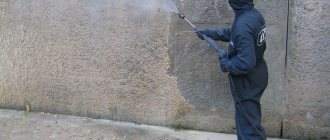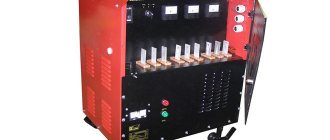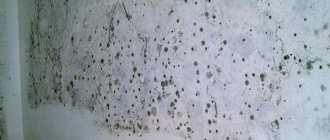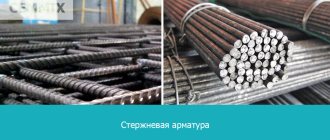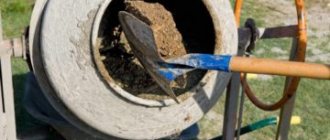In the modern world, it is almost impossible to ensure that buildings and structures are not influenced by factors of man-made aggression.
Concrete and reinforced concrete structures are usually operated outdoors; in industrial and technical premises they can also be exposed to various aggressive influences.
Under such conditions, so-called concrete corrosion can occur - gradual destruction of the structure of the material, accompanied by a progressive decrease in technical characteristics.
In order to prevent the occurrence of emergency situations, various methods of protecting concrete from corrosion are used, which are selected depending on various factors. Let's consider the main methods of protecting concrete.
Important!
Requirements for corrosion protection of building structures when exposed to aggressive environments with temperatures from –70°C to plus +50°C are regulated by SP 28.13330.2017.
Aggressive influences on concrete
External influences and aggressive environments are classified as follows:
- according to physical state - gaseous, liquid and solid;
- in accordance with the intensity of the impact - non-aggressive, slightly aggressive, moderately aggressive, highly aggressive;
- by the nature of the impact they have on concrete - chemical, biological, mechanical.
Important!
If a structure is simultaneously exposed to several different aggressive environments, then the degree of exposure is determined by the most aggressive one.
Armature
In all environments, carbon and low-alloy steels used to make reinforcement cages will not be as reliable as possible, so they are additionally protected from corrosion. Concrete is the most reliable protector of reinforcement. For the manufacture of fittings, carbon and low-alloy steels from various metallurgical plants are used. Of all the metals used in industry, iron suffers most from corrosion due to weather conditions and from exposure to aggressive environments. Therefore, the issue of corrosion processes of reinforcement is of great practical importance.
How to determine the degree of aggressiveness of environments
The level of aggressiveness of environments is determined in accordance with regulatory documents or on the basis of studies performed.
It should also be taken into account that for every 10°C increase in operating temperature above 20°C, the degree of aggressiveness increases by one level.
For massive, lightly reinforced structures, the degree of aggressive impact is reduced by one level.
When combining the influence of aggressive environments and mechanical stress (for example, abrasion and humidity), the degree of aggressive impact increases by one level.
Types of concrete corrosion
There are several types of concrete corrosion, each of which is caused by the influence of certain aggressive external influences.
Chemical corrosion
This type of corrosion occurs as a result of exposure to chemical environments. Depending on what substances act on concrete, chemical corrosion occurs:
- acidic;
- alkaline;
- saline.
Important!
It makes sense to talk about chemical corrosion not only in the context of concrete, which is used in the construction of industrial enterprises. Natural waters and moisture from atmospheric precipitation may contain salts, alkalis, and acids, which occurs as a result of emissions from industrial enterprises entering the atmosphere and water bodies (a man-made factor).
Calcium hydroxide dissolution (leaching)
Ca hydroxide or quicklime can get into concrete during mixing or processing of concrete mixtures. Subsequently, when exposed to humidity, calcium hydroxide is easily dissolved by water and washed out of the concrete, weakening its structure. In this case, efflorescence appears on the surface of the concrete.
Some factors enhance the processes of calcium hydroxide leaching:
- air temperature about +20°C;
- constant exposure to moisture (in this case, silica, alumina and iron oxides are also washed out, and the concrete acquires a loose structure);
- a large proportion of aggregates containing calcium hydroxide increases the intensity of their leaching.
Important!
Water, subject to constant exposure, is an aggressive environment for concrete.
Acid corrosion of concrete
Acid corrosion is caused by exposure to acids. Natural waters may contain hydrochloric, sulfuric, nitric and other mineral and organic acids.
The alkaline components of concrete enter into chemical neutralization reactions with acids to form easily soluble salts. The leaching of salts weakens and loosens the structure of concrete.
Particularly undesirable are reactions with the formation of hydrosulfoaluminates, the crystals of which, during their growth, lead to an increase in internal stresses in concrete.
Salt corrosion of concrete
This type of corrosion can be caused by excessive use of salts as antifreeze additives. The resulting hydrated compounds can expand under high humidity conditions, causing cracks to appear in the concrete.
Biocorrosion
Biological corrosion of concrete is caused by the action of organic acids, which are contained in the metabolic products of various fungi, molds, bacteria, mosses, and lichens. Their development is possible as a result of exposure to moisture on concrete.
Physical corrosion of concrete
It is caused by both mechanical stress (abrasion, vibration) and freeze-thaw cycles.
Radiation corrosion of concrete
Radiation irradiation of concrete structures leads to the removal of crystallized water from the concrete structure, which leads to the appearance of cracks and a decrease in the strength of the material.
Chemical additives
Chemical additives to concrete make it possible to make concrete with much better performance characteristics. This is achieved by increasing the density of concrete, which makes it possible to reduce the penetration of various aggressors into the concrete; even the reinforcement that is located in such concrete is much less susceptible to corrosion.
Chemical additives make it possible to close the pores of concrete, which leads to a significant increase in the frost resistance of concrete.
The most popular chemical additives in concrete , which increase its strength, resistance to destruction and other characteristics are:
- Plasticizers
- Antifreeze additives in concrete
- Additives that increase the water resistance of concrete
- Air-entraining additives
- Concrete retarders
- Anti-corrosion additives for fittings
Quite often they use additives that have a complex effect on concrete; they change several characteristics of concrete at once. Sometimes, improving some characteristics, you have to sacrifice others.
See also: Strength of concrete
Concrete protection measures
The main methods of protecting concrete from corrosion are divided into primary, secondary and special.
For slightly aggressive environments, primary protection and, in some cases, secondary protection are usually used. For moderately and highly aggressive environments - primary, secondary and, if necessary, special.
Measures to protect concrete are determined at the pre-design and design stages, as well as during construction, reconstruction and direct operation of buildings:
- At the pre-design stage , as well as during surveys and research, the aggressiveness of the environment is determined, forecasts are made for changes in these conditions, and the degree of influence of aggressive factors is assessed.
- When developing a project, materials (for example, certain types of cement) and additives are selected, measures are developed to reduce the permeability of concrete, protective materials and measures are selected to reduce the degree of aggressiveness of the environment. Basically, various additives for concrete are used, for example, water repellents, as well as impregnations and other methods of waterproofing; in addition, measures for installing ventilation or wastewater treatment may be planned. Special protective measures are also defined.
- At the construction or reconstruction stage , materials and fillers with increased corrosion resistance, measures for effective mixing, laying and processing of concrete are used to obtain high-density material, treatment with biocides, impregnations, and finishing materials.
- During operation, measures are taken to protect products from moisture, monitor the condition of the product, and restore anti-corrosion protection.
Primary protection methods
Requirements for concrete that will be used under conditions of exposure to aggressive environments are determined by regulatory documentation.
Primary protection measures for concrete include the following:
- Selection of cements that will be resistant to aggressive environments. For example, if it is planned to use concrete in sulfate-containing waters, sulfate-resistant or pozzolanic cements are used. Also, for the preparation of concrete that will be used in aggressive environments, aluminous cements, Portland cements, slag Portland cements, binders of low water demand and non-shrinkage are used. The choice of cement depends on the type and physical state of the aggressive media.
- Selection of placeholders . Typically the fine aggregate used is Class I quartz sand or porous sand, and in some cases Class II sand; as coarse aggregates - fractionated crushed stone, as well as gravel and crushed stone from gravel with a crushability grade of at least 800 or crushed stone from sedimentary rocks with a crushability grade of at least 600 and water absorption not higher than 2%.
- Use of special chemical additives . These include plasticizers, which make it possible to obtain concrete of higher density (reduced permeability) and at the same time reduce the cost of concrete processing and cement consumption; water repellents that increase the water resistance and frost resistance of concrete; polypropylene and basalt fiber, which reduce shrinkage and reduce the abrasion of concrete.
- Development of design solutions that reduce concrete corrosion and protect reinforcement.
Measures to prevent corrosion of reinforced concrete
It is important to protect not only the concrete itself from rust, but also the reinforcement contained in reinforced concrete products. There are several methods of this protection:
- Use only high-quality material for the manufacture of concrete with the addition of inhibitors.
- Protect the reinforcement with an oxide film.
- The metal must be selected with improved characteristics.
A few tips for protecting reinforcement:
- The environment surrounding the metal rods will be the concrete itself, so the main protection should be there. The level of thiocyanates and chlorides, which contribute to the development of the rust process, should be reduced.
- If it is necessary to periodically wet a reinforced concrete structure, it is recommended to first treat it with bitumen impregnations. This is the only way to reduce the percentage of moisture penetration and slow down the cathodic process.
- The concrete composition of the mixture must initially contain corrosion inhibitors.
- Corrosive passivation of reinforcement and the formation of oxide films under the influence of the environment created by reinforced concrete provides good protection against rust.
Anti-corrosion composition for concrete (1 video)
Protective agents and additives (30 photos)
Polypropylene fiber
Universal polypropylene reinforcing fiber for adding to the solution.
More details
Proven chemical additives produced by ]CEMMIX[/anchor] provide regulatory primary protection of concrete and reinforced concrete structures during their manufacturing process:
- To increase the water resistance of concrete, water-repellent additives are also used, for example, the plasticizer and water-repellent agent CemAqua.
- To obtain highly flexible (up to P4) concrete mixtures and reduce labor costs for processing and laying concrete, the Plastix plasticizer is used.
- To obtain highly flexible (up to P5) concrete mixtures and reduce labor costs for processing and laying concrete, superplasticizers CemPlast and CemBase are used.
- To fill heated floors, the plasticizing and strengthening additive CemThermo is used, which increases the mobility and spreadability of the building mixture. The mixture acquires a homogeneous and dense structure. The process of leveling the floor is easier and the concrete surface is smooth.
- For brick or stone masonry and plastering of surfaces, CemStone is used, a complex additive for masonry and mortars; gives the mixture plasticity and improves workability. Prevents separation and water separation of the mortar mixture.
- To reduce work time, CemFix is used - a hardening accelerator - a complex additive for concrete and mortar mixtures. It has a combined accelerating and plasticizing effect.
- To perform work at subzero temperatures, complex additives for concrete and mortar mixtures CemFrio and HotIce are used. Which have a combined antifreeze, accelerating, plasticizing effect.
The possibility of using polypropylene and basalt fibers CEMMIX in mixtures, which reduce the abrasion of concrete, reduce shrinkage, prevents the appearance of shrinkage cracks, and also increases the strength and impact strength of concrete, and in small elements, for example, curbs, it allows you to do without metal reinforcement.
Important!
The total amount of additives in concrete should not exceed 5% by weight of cement. Otherwise, research is required.
Methods for secondary protection of concrete
These measures mainly include measures that allow the structure to be physically isolated from aggressive influences. These include:
- adhesive waterproofing;
- mastics;
- impregnation;
- biocides and antiseptics;
- paint and varnish compositions, plaster coatings with special properties;
- cladding
Special protection methods
These measures are used in cases where any specific technogenic impacts on concrete are expected.
Protection of concrete from electrocorrosion
When structures are exposed to stray currents, the following protective measures are used:
- use of concrete water resistance classes not lower than W6;
- the use of additives to produce concrete with increased electrical resistance;
- compliance with the thickness of the protective layer of concrete (at least 20 mm);
- refusal of steel reinforcement.
Fire safety
To ensure fire safety, protective materials are used, which must be tested for compatibility with other anti-corrosion measures.
Are used:
- fire retardants;
- fire retardant coatings;
- lining materials.
Lining materials are facing coatings with heat-insulating and fire-resistant properties, as well as resistance to chemicals.
What leads to rusting of the reinforcement cage
There are several reasons for rust to appear on the metal inside the concrete mass. And these are not always external influences.
- Internal corrosion can be caused by the presence of a large number of aggressive components in the water used to mix the concrete mixture. In addition, to create reinforced concrete, you cannot use a composition containing more than 2% (by weight of cement) calcium chloride. Since this element significantly accelerates the corrosion of reinforcement in concrete when used in any environment.
- The density of laying the concrete mixture is of no small importance. The fact is that the presence of a large number of pores, voids, cavities allows moisture and air to penetrate inside the product, to the reinforcement frame. As a result, different electrical potentials arise in different parts of the metal circuit, which leads to electrochemical corrosion.
- The concept of physical corrosion is associated with the destruction of concrete as a result of its alternate freezing and thawing. This trouble can be avoided by creating favorable conditions while the concrete gains strength to a given value.
In order to correctly assess the situation and take measures to correct it, it is necessary to understand the level of the threat. To determine the degree of corrosion of reinforcement and concrete, physical and chemical methods are used:
- Study of the composition of components newly formed in the concrete mass under the influence of aggressive substances. Research is carried out in the laboratory using differential thermal and x-ray structural diagnostics on specially selected samples.
- Conducting a visual inspection of the altered structure of concrete in a structure using a magnifying glass. This method allows you to identify many surface defects.
- Powerful microscopes help to detect the nature of the arrangement and connection of cement stone elements with aggregate grains. As well as the state of contact of concrete with reinforcement, dimensions and direction of propagation of cracks.
To determine the strength characteristics of operating concrete and reinforced concrete structures, non-destructive testing methods are used in accordance with the recommendations and requirements of GOST 18105-86.
Plastix
Multifunctional plasticizing and water-reducing additive for concrete.
More details
They are made on the basis of polymers, protect concrete from impact loads and abrasive effects, and have high elasticity.
Lining is used as a special method of protection, for example, for blast furnaces, forges, mines, etc. In this case, the requirements for concrete are also increased - concrete of high strength and durability is used. Such concrete can be obtained only with the use of additives: plasticizers and superplasticizers, which make it possible to obtain a material of high density and strength.
Anchor connections
For fastening structures and equipment to a concrete base, embedded parts are used. Cement or epoxy mortars are used to fix them.
Cement anchor compositions are inexpensive and durable in compression.
Important!
The choice of composition for anchoring is made in accordance with design calculations.
Cement-based compounds, unlike epoxy ones, can be used on wet substrates. To speed up the hardening process of cement mortar (which normally takes 7–28 days), concrete hardening accelerators are used.
CemFix
A highly effective accelerator is a complex additive for concrete and mortar mixtures requiring high early strength.
More details
Hardening accelerator CemFix ]Cemmix[/anchor] is a complex additive that has a plasticizing and accelerating hardening effect. Its composition is adapted to domestic cements.
CemFix increases the early strength of concrete by 20–40%, and the brand strength by 15–20%, provides high workability, increased strength and water resistance, saves up to 10% of cement, and protects reinforcement and embedded parts from corrosion.
Modern measures to protect concrete products and structures from aggressive influences of natural and man-made origin include the correct choice of materials and the use of modern concrete additives. One of the leaders in the production of such additives is ]Cemmix[/anchor], which provides a wide selection of high-quality and affordable materials.
You can buy CemPlast, CemBase CEMMIX without leaving your home, with discounts from 5 to 33%!!!!
Buy on Ozon
Buy on Yandex.Market
Buy on Wildberries
Buy at Leroy Merlin
Or you can find the nearest official dealer in your region on our map
← Concrete waterproofing: in what cases is it required, and what
How to destroy mold on concrete →
Return to list
Comments
Processes of destruction of reinforcement in concrete
If the concrete structure contains iron reinforcement or reinforced concrete, another type of damage to this material may occur, which occurs due to the destruction of the reinforcement.
The reinforcement in the middle of the cement stone rusts or the formation of iron corrosion products occurs due to the impact of water on the concrete or the presence of hydrogen sulfide, chlorine and sulfur dioxide gases in the air. In terms of volume, these materials exceed the original volume that was specified for the reinforced concrete structure, and this, in turn, causes internal stress and, as a consequence, cracking of the concrete.
Air and moisture penetrate into the inner layers of the product to the reinforcement due to the presence of pores in the cement stone. Their supply to the surface is uneven and for this reason electrochemical corrosion of the reinforcement may occur in different areas, the rate of which depends on the level of moisture permeability and the size of the porosity of the cement stone.
If concrete has been exposed to air for a long time, under the influence of carbon dioxide, a thin layer of a protective film can form on the surface. This coating does not dissolve in water and is not affected by salts. This process is called carbonization. It provides protection against corrosion of cement stone, but can cause such a phenomenon as corrosion of reinforcement.
News
We are always ready to help
Cemmix has opened a free hotline
to help you with any questions related to construction using concrete additives. Call and ask, our consultants are always ready to help!
Hyperplasticizer
Hyperplasticizers are a new type of plasticizing additives for concrete, ensuring the mobility of the mixture above P5. In addition to plasticity, they increase the water resistance and frost resistance of concrete by 2-3 times.
